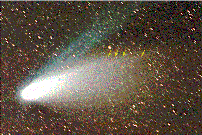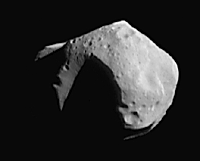Click on image for full size
NASA
NEAR FLyby of Asteroid Mathilde
News story originally written on July 3, 1997
On June 27, 1997, the NEAR spacecraft passed within 1200 km of the asteroid Mathilde. NEAR stands for Near Earth Asteroid Rendevous. It is one of NASA's Discovery missions, a series of small-scale spacecraft which are designed in less than three years and cost less than $150 million each.
Mathilde is a large asteroid. Its diameter was estimated to be 60 km and its mass was estimated to be 1x1017 kg. This makes it the most massive asteroid yet to be visited by a spacecraft.
Mathilde is also unique because it has an extremely long period of rotation. In fact, scientists have said that it hardly moves! It takes 17.5 days for Mathilde to rotate just once on its own axis.
This asteroid is located in the Main Asteroid Belt. It is assumed that asteroids in the Main Asteroid Belt date from the beginning of the solar system. Mathilde's dark surface (reflectivity is less than 4%) is believed to consist of carbon-rich materials that have not been altered by planet-building processes. Understanding asteroids such as Mathilde will point towards the solar system's origin.
The NEAR spacecraft has found five craters over 20 km across on the surface of Mathilde. No satellites (moons) have been found yet. And no evidence of water has been detected.
You might also be interested in:

NASA has chosen CONTOUR as the next mission of its Discovery Program. CONTOUR stands for the Comet Nucleus Tour. CONTOUR will take spectral image maps of at least three comet nuclei and analyze the dust
...more
It was another exciting and frustrating year for the space science program. It seemed that every step forward led to one backwards. Either way, NASA led the way to a great century of discovery. Unfortunately,
...more
The Space Shuttle Discovery lifted off from Kennedy Space Center at 2:19 p.m. EST, October 29th. The sky was clear and the weather was great as Discovery took 8 1/2 minutes to reach orbit for the Unitied
...more
A moon was discovered orbiting the asteroid, Eugenia. This is only the second time in history that a satellite has been seen circling an asteroid. A special mirror allowed scientists to find the moon
...more
Will Russia ever put the service module for the International Space Station in space? NASA officials are demanding an answer from the Russian government. The necessary service module is currently waiting
...more
During a period of about two days in early May, 1998, the ACE spacecraft was immersed in plasma associated with a coronal mass ejection (CME). The SWICS instrument on ACE, which determines unambiguously
...more
J.S. Maini of the Canadian Forest Service has referred to forests as the "heart and lungs of the world." Forests reduce soil erosion, maintain water quality, contribute to atmospheric humidity and cloud
...more















